Chamomile Lawn: How to Grow This Better Ground Cover
Author: Chris Miller | Editor: Omar Alonso
Review & Research: Jen Worst & Chris Miller

Growing a chamomile lawn ground cover has become a perfectly acceptable alternative to a grass yard. It can be maintained all the same, played in by kids and pets, and mowed to your desired height.
Grass is typically the staple component of a lawn. But if you’ve been poking your nose into gardening websites and channels on social media, you'll notice that many people are opting for chamomile lawns.
Apart from being soft and evergreen even in dry summers, they come with the added benefit of fragrance. Unlike grass lawns, they don’t have to be mowed, which makes them a great choice for smaller gardens or wild yards.
If you don’t know the inner workings of a chamomile lawn, you’ve come to the right place to learn all about it. The main positives, other than the look, is that people enjoy the health related benefits of chamomile. So even having it around becomes associated with feeling calm.
Before You Create a Chamomile Lawn
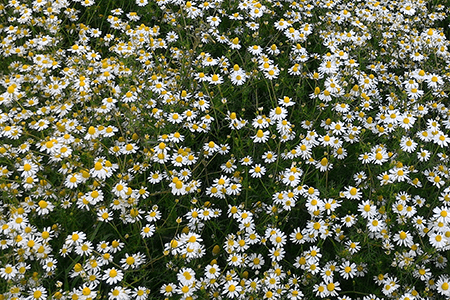
Before you figure out which type of chamomile suits you best, there are a few other things to do. The first step in establishing most lawns is to remove weeds and unwanted plants.
It’s no different for a chamomile lawn. You might also want to spray some weed killer a couple of times to avoid the likes of nettles, brambles, clovers, and thistles. You need them gone so your chamomile can get established first and then block those out.
Wait for a fortnight after spraying the weed remover to figure out if you need to do another round. During this time, the weed remover also targets dormant weed seeds and stops them from germination.
Determine if you need to do another round of spraying. If not, get started on the next step, which is picking the right chamomile for you.
Picking Your Chamomile Lawn Seeds
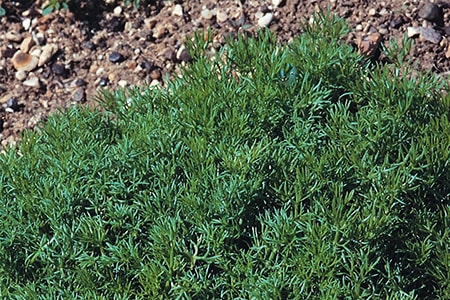
You have two types of chamomile to choose from. Really, for lawns, you only have one choice and we mention the second choice just so you know to avoid it.
Roman chamomile or Chamaemelum nobile is a perennial plant and is grown best on the ground. You typically want the Roman variety in the case of growing it for as a lawn cover.
German chamomile or Matricaria recutita is an annual plant which is used medicinally in teas and essential oils. The German variety grows too tall for most people's tastes.
It can be confusing to pick them by looking at pictures because both varieties have flowers like daisies and feathery leaves. They also taste like apples and smell the same way when you crush them. The difference is in the way they grow.
Roman chamomile gets to a height of 6 inches at best while German chamomile grows from 12 to 20 inches. If you want an aromatic lawn, you must opt for Roman chamomiles.
There's one more choice for lawns, called Treneague. It is the non-flowering type and doesn't grow from seeds. So, you must buy a plant and let it propagate. We recommend going for Roman chamomile.
When to Plant Chamomile Seeds
Whether planting chamomile seeds or transplants, do so soon after the last spring frost. They won't thrive well (or possibly at all) if exposed to freezing temperatures.
Water them as soon as you plant them and then provide 1 inch of water per week until they're fully established. If you can mix in compost and fertilizer before planting, do so. Plant them 4 to 8 inches apart.
How to Grow Chamomile Ground Cover
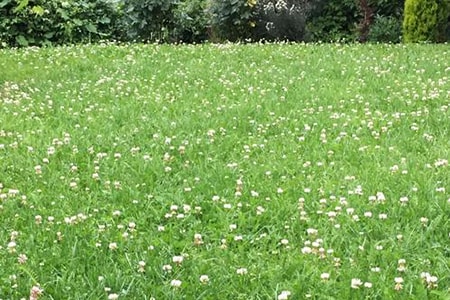
It's best to grow chamomile plants in the full sun. But if that is not always a choice, don’t worry. They can tolerate a little bit of shade and still be just fine.
These plants need light soil like sandy loam. Dry or stone-filled soil along with heavy clay is just not good. This is due to poor draining capabilities and impairment of root growth.
As mentioned before, unlike grass, chamomile doesn’t do well in the presence of weeds. So, make sure you rid your yard of them all.
Some varieties, that are not cultivars, can be sown from seeds and grown in pots till they are large enough for you to transplant them into the lawn. Spring is the best time to buy seeds or divide the existing lot.
You'll do best to do so with a heated germination pad that is at 65 degrees Fahrenheit in high-quality compost mixed with perlite. You can use perlite or vermiculite, depending on what you have easy access to.
Be sure to plant them 4 to 8 inches apart. If you plant them any closer than that, you will get rapid coverage but the plants will fill in quickly and densely, and you might have to replant them due to poor health.
Not only can this overwhelm the soil, zapping it of nutrients, but it restricts air flow within the chamomile ground cover, leading to disease and an increase in pest infestation.
By late spring they will be big enough for you to transplant them to the lawn. No dealing with various types of lawn mowers, weed eaters, or anything else. Just let it thrive!
Watch Your Growing Chamomile for These Issues
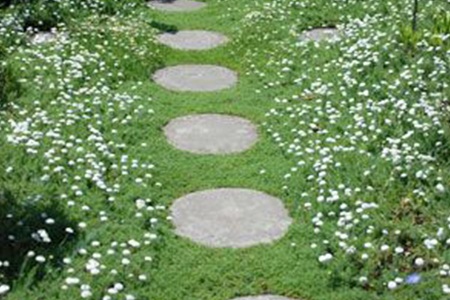
When you have a new chamomile lawn, you must take a couple of precautions starting with the foot traffic in their space. For the first 12 weeks after planting them, no one must walk on them.
And, in the first year, the traffic must be kept to a minimum with no compromise whatsoever because young lawns are delicate. The rule of thumb is to stay out of the way until you start to see the leaves of individual seedlings touching one another.
You could add paving stones to the lawn to keep wear and tear at a minimum. However, once the lawn is established, they can handle a regular amount of footfall. It just takes patience to stay out of it until then.
Extra Chamomile Lawn Tips
Once you start to see the bloom, remove some of the flowers to help the plant increase foliage. Keep some of them on so that your lawn does not lose its color and scent. I know it seems counter-intuitive, but removing some leaves helps encourage better growth.
If you’re going for the Treneague cultivar model, which is non-flowering, you'll have the most success in the USDA zone 8, which is one of the 13 hardiness zones in the US.
This is because it grows closer to the ground in a mat form. This is an English chamomile variety that must be planted 12 inches apart to keep the overall costs down and you will find the area to be thick.
Growing a blanket of chamomile in a meadow or on a slope is a practical, time-saving, and economical option. Gardeners like it for geometric arrangement on a landscape of grass and similar ground covers.
If you grow a wide swath of chamomiles, you can trace paths along borders, retaining walls, and retaining wall alternatives. You can also place them strategically near a garden bench. And of course, you can cover your entire lawn in a chamomile ground cover, which looks beautiful.
Benefits of a Chamomile Lawn
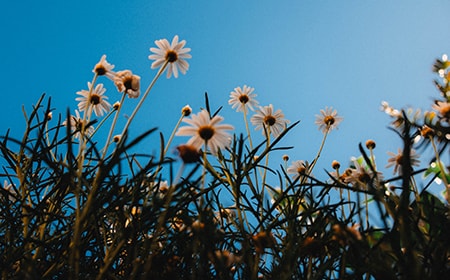
Growing a chamomile lawn not only results in a pretty view but has so many other practical benefits. It reduces and sometimes even eliminates the need to mow your garden. It needs fertilizing and weeding only in the spring.
You should maintain minimum foot traffic for best results, at least for the first year if not longer. These lawns help control pollution from noise, gas, and oil fumes.
Chamomile is an excellent plant to grow in areas that are otherwise tough to manage. Since there's no mandatory mowing required, you can enjoy a little extra free time from yard work.
If you grow the mat variety, you can make artistic rings around the other trees in your yard if you don't opt for a full ground covering.
Chamomile enriches the soil in the garden since it is an excellent source of nitrogen. The plant is drought resistant and thrives well even during dry spells once established.
It's easy to manage and rather inexpensive. The plants also spreads well, covering a lot of area with just a few plants, given the time to do so.
Chamomile is a great companion plant because of its natural anti-bacterial and anti-fungal properties. It is the perfect match for apple and other fruit trees.
It is also great around broccoli, all the types of kale, and cabbage plants along with beans, cucumbers, and onions. If you want to increase the oil production of basil, rosemary, and mint trees and make them more potent, chamomile is your guy.
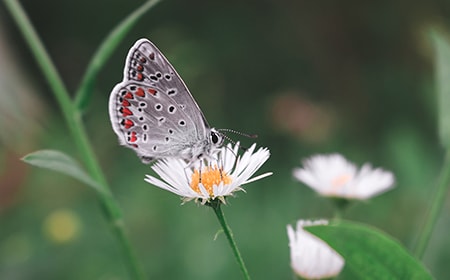
These plants also attract the right kind of insects and pollinators like hoverflies, wasps, honeybees, and all types of ladybugs into your lawn and garden. Additionally, it also keeps mosquitoes away.
Chamomile plants are high in nutrients and create a lot of green space wherever they are planted. They're also a great mulch which means you can cut them down at the end of a season and leave them in place to renew the soil.
These plants also make a great addition to your compost pile thanks to their rich mineral content.
Their flowers are edible but not overpowering. They also have a sweet aroma. You can add them to desserts like strawberry chamomile cake or lemon chamomile shortbread cookies.
Chamomile in many forms is known to promote sleep and relaxation. This is what makes it a popular evening tea. When used in herb form, it is said to relieve anxiety and stress.
Now That's a Chamomile Lawn!
Some varieties of chamomile are not the easiest to grow. In fact, they can be a bit expensive too. But if you make sure you know the ground rules of sowing, propagating, and harvesting the specific type, it's very much doable and also an enjoyable task.
Before the onset of spring, clear out the weeds and spray some weed killer. Find the right type of chamomile depending on the results you want. Once you pick a variety, plant your chamomile and be sure to keep the foot traffic in that area to a minimum.
Plant them at the right distance and allow them to grow. Once you see the leaves touching each other, you can pluck them a bit to encourage the growth of thicker foliage.
All you need to do after that is wait for the sweet smell of chamomile to fill your lawn. Enjoy the soft landscape while it stays green throughout the year with no effort on your part. And now you have a happy chamomile lawn.



